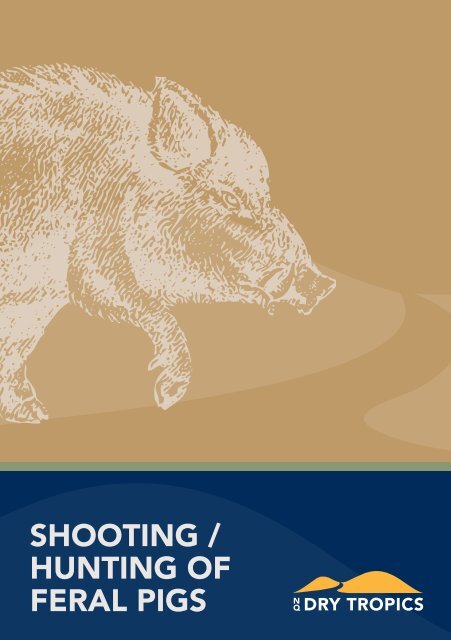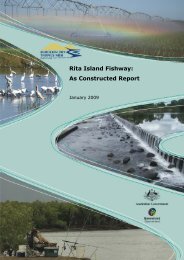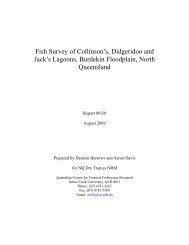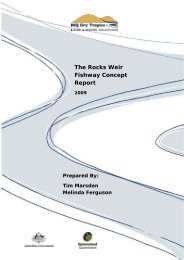SHOOTING / HUNTING OF FERAL PIGS - Wiki - NQ Dry Tropics
SHOOTING / HUNTING OF FERAL PIGS - Wiki - NQ Dry Tropics
SHOOTING / HUNTING OF FERAL PIGS - Wiki - NQ Dry Tropics
Create successful ePaper yourself
Turn your PDF publications into a flip-book with our unique Google optimized e-Paper software.
<strong>SHOOTING</strong> /<br />
<strong>HUNTING</strong> <strong>OF</strong><br />
<strong>FERAL</strong> <strong>PIGS</strong>
This practical guide provides advice that will<br />
help you manage feral pig problems in the<br />
<strong>Dry</strong> <strong>Tropics</strong> region.<br />
Several techniques are available to control feral pigs. Generally no stand alone technique is<br />
sufficient for each situation so a suite of integrated techniques or combination of methods is<br />
necessary. When developing a pig control strategy, managers need to consider what problems the<br />
pigs are causing and then decide which control option or combination of options is most suitable<br />
to reduce the problem.<br />
Table of Contents<br />
3 Introduction<br />
3 Advantages and Disadvantages<br />
4 Ground hunting / shooting<br />
6 Aerial shooting<br />
6 Advantages and Disadvantages<br />
8 Dogging<br />
8 Advantages and Disadvantages<br />
10 Commercial Harvesting<br />
PAGE 2
INTRODUCTION<br />
Hunting has long been established as a control technique for feral pigs (sus scrofa), with ground<br />
shooting or hunting with dogs as the primary method of pig control for many landholders. Hunting<br />
of feral pigs is a major recreational pursuit throughout Australia, as pigs are considered the main<br />
feral animal to be hunted in Australia. Aerial shooting is increasingly becoming more popular<br />
since the 1980s.<br />
Limited information is available on the use of hunting as a control technique. Aerial shooting has<br />
been shown to be an efficient and cost effective method of controlling pigs over extensive areas in<br />
remote locations and in sparsely vegetated landscapes. However ground hunting is a very labour<br />
intensive and ineffective method of controlling pigs over large areas, particularly when pigs are<br />
at low densities. The main benefit of hunting is as a mopping up exercise to eliminate residual<br />
populations after more effective control programs have been used. The use of recreational hunters<br />
to control pig numbers is seldom effective and may disperse pigs through regular disturbance.<br />
ADVANTAGES of hunting:<br />
• Aerial shooting is effective in extensive<br />
and/or inaccessible areas and ideal as<br />
a quick and effective initial population<br />
knockdown technique.<br />
• Ground shooting is useful as a<br />
mopping up technique after other more<br />
effective control techniques have been<br />
implemented.<br />
• Useful where small numbers of pigs or<br />
individuals are causing extensive economic<br />
problems.<br />
• Can be used to eradicate small<br />
isolated populations.<br />
• Economic returns can be made from<br />
the sale of pig carcasses to commercial<br />
harvesting companies.<br />
• Some economic returns to local<br />
communities from hunter expenditure.<br />
• Can be used in conjunction with other<br />
control techniques.<br />
• Little threat to non-target species.<br />
DISADVANTAGES of hunting:<br />
• Recreational hunting is ineffective as a<br />
population control technique.<br />
• Aerial shooting can be expensive and<br />
ineffective in dense vegetation.<br />
• Hunters have transported pigs into<br />
‘clean’ areas.<br />
• Usually only adult pigs are targeted.<br />
• As the population diminishes, hunting<br />
success becomes more uncertain and<br />
hunters will cease hunting.<br />
• Hunting is applicable only in relatively<br />
small, easily accessible areas.<br />
• Hunters have also been accused of theft<br />
of equipment, damaging fences and<br />
leaving gates open. In more remote areas,<br />
hunters illegally trespassing on land is<br />
commonplace.
GROUND<br />
<strong>HUNTING</strong> /<br />
<strong>SHOOTING</strong><br />
Ground hunting is possibly the most widely<br />
used feral pig control technique. Shooting<br />
using rifles, long bows and cross bows are<br />
used by different hunters. Using dogs to find<br />
and hold pigs and using knives to dispatch<br />
the captured pigs is also a very common<br />
hunting technique. Hunting can include<br />
individual hunters stalking pigs, groups of<br />
hunters chasing pigs into more accessible<br />
shooting terrain, spotlight shooting or<br />
opportunistic shooting from vehicles.<br />
Hunting is usually not effective in reducing<br />
pig populations unless concentrated on small<br />
isolated populations of pigs. Usually only 15%<br />
to 20% of the population will be controlled<br />
by hunting alone. Lack of accessibility into<br />
pig populated areas and being unable to<br />
see pigs due to dense vegetative cover will<br />
limit the effectiveness of hunting. Feral pigs<br />
are cryptic animals and difficult to locate<br />
and are intelligent and will quickly adapt to<br />
harassment from hunters and move to<br />
other locations.<br />
However, hunting has been shown to be<br />
useful as a follow up technique to remove<br />
remnant populations left over from other<br />
control operations. Extensive poisoning or<br />
trapping programs will never eradicate pigs<br />
from an area; there will always be difficult to<br />
control individuals left behind. Hunting in this<br />
situation, especially in small accessible areas,<br />
is a recommended technique to control the<br />
last few individuals.<br />
Hunting is also a low cost alternative (usually<br />
at no cost to the landholder) to other control<br />
techniques and, as such, some landholders<br />
rely solely on shooting by volunteers or<br />
people who will sometimes pay to hunt<br />
as their primary control option. These<br />
landholders regard shooting as an effective<br />
technique as they can see the captured pigs<br />
or know how many have been controlled.<br />
Also, the pig damage usually diminishes after<br />
hunting; generally this is entirely due to the<br />
pigs being chased into other areas or onto<br />
neighbouring farms where the damage<br />
will continue.<br />
The most effective use of hunting is in<br />
intensive agricultural areas where individual<br />
or a small groups of pigs can cause extensive<br />
damage. Even an expensive method to<br />
control these small numbers of pigs is cost<br />
effective. Intensive hunting using spot<br />
lights, lying in wait and night vision sights<br />
are effective in these situations. Some<br />
individual boars for example will quickly lock<br />
onto a quality food resource such as a grain<br />
silo, bags of grain in sheds etc and cause<br />
extensive damage. Intensive hunting is an<br />
effective technique in these situations.<br />
PAGE 4<br />
GROUND <strong>HUNTING</strong> / <strong>SHOOTING</strong>
A major problem with hunting is, as the population becomes more and more scarce, the number of<br />
pigs successfully hunted is reduced to the point where hunters will simply give up, as it is not worth<br />
their effort for so few pigs. This point is usually reached when there is still a viable pig population<br />
present so the population will quickly recover.<br />
A technique using night vision scopes attached to rifles has been shown to be effective in open<br />
terrain. Pigs do not have good vision especially at night so they become confused in the dark and<br />
are not aware of where gunfire originates. A number of pigs in a group may be shot before they<br />
disperse. Thermal imaging goggles and rifle sight are being used in some situations; as the price<br />
drops on this equipment more use can be made of this technology.<br />
Humaneness of hunting is debatable. Aerial and ground shooting if done by competent marksmen<br />
and following the Standard Operating Procedures is considered humane. However, shooting over<br />
extreme distances, incompetent marksmen or being unable to locate wounded pigs can lead to<br />
humane issues.<br />
GROUND <strong>HUNTING</strong> / <strong>SHOOTING</strong> PAGE 5
AERIAL <strong>SHOOTING</strong><br />
Aerial shooting is regarded as the most effective method to achieve fast population knockdown in<br />
a short time period and can be used in inaccessible areas and over all seasons of the year.<br />
Aerial shooting<br />
ADVANTAGES include:<br />
• Labour efficient.<br />
• Unaffected by seasonal conditions.<br />
• Humane and target specific.<br />
• Effective in open terrain, in remote<br />
locations or in inaccessible areas where<br />
ground control techniques are impossible.<br />
• Cost efficient where pigs are in high<br />
numbers and observable from the air.<br />
• Numbers controlled are known and can be<br />
used for population monitoring purposes.<br />
• Helicopter shooting can be used to form<br />
coordinated group control programs.<br />
DISADVANTAGES include:<br />
• Dispersal of animals; during an intense<br />
aerial shooting program a feral pig was<br />
shown by radio tracking to have dispersed<br />
over 100km away.<br />
• Increasing costs as numbers decrease and<br />
in dense vegetation, woodland and forest.<br />
• Ineffectiveness of annual shoots in keeping<br />
numbers low. Helicopter shooting should<br />
not be considered as a stand-alone<br />
control measure, as it will only reduce the<br />
population by a limited amount and will<br />
require follow up with other<br />
control techniques.<br />
PAGE 6<br />
AERIAL <strong>HUNTING</strong> / <strong>SHOOTING</strong>
The high cost of aircraft hire is the major impediment to this technique, although the high number<br />
of pigs controlled over a short time period can make this technique very cost effective in most<br />
situations. However the high costs usually force aerial shooting to be conducted only spasmodically<br />
so it can be ineffective in keeping pig populations at low levels over a long time frame. Aerial<br />
shooting is best used in combination with other techniques (as part of an integrated control<br />
program) to maintain populations at a low level over a long time period.<br />
The cost effectiveness of aerial shooting is dependent on pig density, vegetation cover and the<br />
efficiency of the operators. In areas where pigs have little cover or are concentrated into small<br />
areas (around waterholes for example) cost effectiveness can be very high. A single shooter with an<br />
experienced pilot in a small helicopter has killed up to 3000 pigs daily in open grassland plains in<br />
north Queensland.<br />
The weapons most suitable are either automatic shotguns or semi-automatic large calibre (.308)<br />
rifles. Usually red dot scopes are used to increase accuracy. In suitable terrain, helicopter shooting<br />
can achieve over 80% population knockdown. This technique is also the principle technique<br />
advocated in contingency plans for eradicating feral pigs during exotic disease emergencies.<br />
The increasing availability of small mustering helicopters has<br />
made aerial shooting a more economic option, particularly<br />
in inaccessible areas. Helicopter shooting still has some<br />
shortcomings as some habitat types can conceal pigs from<br />
the air making them difficult to shoot. The use of ‘Judas’ pigs,<br />
similar to the ‘Judas’ goat technique used in feral goat control,<br />
involves the use of a radio collared individual to locate other<br />
animals after it is released and re-joins a group.<br />
AERIAL <strong>HUNTING</strong> BAIT / <strong>SHOOTING</strong> MATERIAL PAGE 7
DOGGING<br />
The use of trained dogs to locate and capture feral pigs is very popular throughout Australia<br />
particularly in north Queensland. As with ground shooting, dogging is not effective in reducing<br />
feral pig populations. Pigs are either flushed out of cover or bailed up and then subsequently shot<br />
by hunters or “dogged” where larger dogs are used to hold the pig so it can be either shot or<br />
stabbed by hunters. Dogs are trained to be finders, bailers or holders and this can be dependent<br />
on their breed and/or their size. Dogs up to 80 kg have been used to capture and hold even very<br />
large pigs over 100 kg. Usually dogs work in packs of 3 to 5. Protective vests are used to minimise<br />
injury to holding dogs and GPS tracker technology can be used to find lost or injured dogs.<br />
However, dogging is considered by some community groups to be inhumane both to the pig and<br />
to the dogs.<br />
The ADVANTAGES of<br />
dogging are:<br />
• Effective in situations where other control<br />
techniques do not work i.e. crops where<br />
lone boars or small groups are living and<br />
are unwilling to enter traps or eat bait<br />
material.<br />
• Low cost to the landholder.<br />
• May cause a rapid reduction in damage.<br />
• Can be coupled with general farming<br />
practices.<br />
The DISADVANTAGES of<br />
dogging are:<br />
• Not effective in reducing the pig<br />
population.<br />
• Only a short term reduction in damage.<br />
• The use of dogs to pursue and hold pigs is<br />
considered inhumane by welfare groups.<br />
• Lost dogs can establish wild dog<br />
populations and cause damage to<br />
livestock.<br />
• High cost of general care and veterinarian<br />
care for injured dogs and costs of<br />
protection equipment.<br />
• Dogs may target other species including<br />
cattle, horses and native animals.<br />
• Dogging tends to disperse the pigs to<br />
neighbouring properties or into new areas.<br />
• When a mob of pigs are encountered dogs<br />
tend to catch few pigs, especially the adult<br />
males who stand to defend while the rest<br />
of the group escapes.<br />
PAGE 8<br />
DOGGING
Dogging is best suited to remove the few remaining pigs left after other more effective control<br />
techniques have been used. However research has shown that even experienced dogs can miss<br />
concealed pigs. Radio transmitters placed on feral pigs, hunting dogs and in the backpacks of<br />
hunters have been used to map their movements. The results showed only 27% of the pigs seen<br />
were captured by the dogs. Hunters passed within 100m of pigs without the dogs scenting the<br />
pigs. This control technique only removed 13% of the pig population present. There have been<br />
reports of a 90% success rate when dogs encountered solitary pigs but that the success rate rapidly<br />
declined as the group size of pigs increased. Another dogging trial showed that at least one-third<br />
of all feral pigs encountered escaped from the dog; when groups of pigs were encountered, usually<br />
only 1 was caught. The effectiveness of dogging depends largely on the skills of the hunter<br />
and dogs.<br />
However dogging has been used successfully in eradication programs in Hawaii, Galápagos Islands<br />
and on Lord Howe Island where other control techniques were unable to be used. Dogging also<br />
remains the primary method of pig control in New Zealand (although they only have a small pig<br />
population) where dogging is regarded as a cultural recreation within the Maori communities and<br />
the pigs are often used in traditional ceremonies.<br />
Hunting with dogs in extensive cropping situations such as grain, sugar cane and banana crops<br />
is also effective when individual boars or small groups cause extensive damage. The dense<br />
vegetation in the crops and the unwillingness of these pigs to enter traps or eat bait material leave<br />
no option but to use dogs and hunting to quickly control the damage before it escalates.<br />
DOGGING<br />
PAGE 9
COMMERCIAL<br />
HARVESTING<br />
Wildlife harvesting occurs when feral pig carcasses are bought to refrigerated containers or “chiller<br />
boxes” and sold to game meat processing companies who then on sell the frozen meat to overseas<br />
countries for human consumption. Hunters must be accredited with Safe Foods Queensland to<br />
sell to the chiller boxes and follow specific health guidelines and operate to an approved quality<br />
assurance program regarding the harvesting of pig carcasses for human consumption.<br />
Commercial and recreational harvesting of pigs is often<br />
encouraged because it is essentially a ‘free’ reduction in pest<br />
density. However, the perceived reduction in feral pig numbers<br />
may not be matched by actual reductions in damage. The main<br />
benefits of harvesting are the economic gains to the harvester,<br />
with potential benefits from reducing damage.<br />
The major disadvantage of commercial harvesting is the population must be maintained at a level<br />
where the economic returns from hunting are more than the cost of hunting. This population level<br />
may be unacceptable to landholders suffering damage from pigs. Other disadvantages include<br />
the targeting of adult pigs over 21 kg (pigs under 21kg are not saleable). These young adults<br />
left behind may quickly reach breeding weight due to more resources being available from the<br />
reduced competition. This may lead to rapid population recovery. Hunters have also been known<br />
to transport live pigs to new areas to establish a “hunting” population closer to where they live.<br />
This relocation occurs throughout Australia and has established many new populations; DNA<br />
analysis has been used to confirm the movement of pigs into new previously unoccupied and<br />
isolated areas.<br />
PAGE 10<br />
COMMERCIAL HARVESTING
The economic return to Australia from commercial hunting of feral pig meat exports varies<br />
between $10 million and $20 million annually and is mostly attributed to the European<br />
market. In Queensland up to 500,000 pig carcasses annually obtained from 2100 accredited<br />
field operators has been recorded. The variable overseas markets dictate prices paid to<br />
hunters and the number of carcasses required. Oversupply of the markets has led to the<br />
closure of the industry in some years.<br />
There are always conflicting views on the positive resource value of feral pigs to some groups and<br />
the negative economic damage caused by pigs to other groups. Hunter organisations regard the<br />
pig as a valuable economic resource while Aboriginal communities regard the pig as a hunting<br />
resource and also as a significant food resource; although most agree that too many pigs is<br />
unacceptable. Many graziers hold no opinion on the positive or negative value of pigs but accept<br />
there is a disease risk to their cattle. Most cropping industries have a negative view of pigs and<br />
regard them as causing serious economic damage to most crops.<br />
COMMERCIAL HARVESTING<br />
PAGE 11
Acknowledgements<br />
This manual contains practical advice<br />
on feral pig control strategies for land<br />
managers in the North Queensland <strong>Dry</strong><br />
<strong>Tropics</strong>. This initiative is funded by the<br />
Australian Government - Caring for our<br />
Country, supported by <strong>NQ</strong> <strong>Dry</strong> <strong>Tropics</strong>.<br />
Author: Dr. Jim Mitchell.<br />
Shooting/Hunting of Feral Pigs<br />
Copyright 2011 <strong>NQ</strong> <strong>Dry</strong> <strong>Tropics</strong> Ltd<br />
Published by <strong>NQ</strong> <strong>Dry</strong> <strong>Tropics</strong> Ltd<br />
trading as <strong>NQ</strong> <strong>Dry</strong> <strong>Tropics</strong>.<br />
The Copyright Act 1968 permits fair<br />
dealing for study, research, news<br />
reporting, criticism or review. Selected<br />
passages, tables or diagrams may be<br />
reproduced for such purposes<br />
provided acknowledgement of the<br />
source is included. Major extracts<br />
of the entire document may not be<br />
reproduced by any process without<br />
written permission of the Chief<br />
Executive Officer, <strong>NQ</strong> <strong>Dry</strong> <strong>Tropics</strong>.<br />
Please reference as:<br />
Mitchell, J 2011, Shooting/Hunting of<br />
Feral Pigs, <strong>NQ</strong> <strong>Dry</strong> <strong>Tropics</strong>, Townsville.<br />
Important Disclaimer: The views and<br />
opinions expressed in this publication<br />
are those of the author. While<br />
reasonable efforts have been<br />
made to ensure the contents of<br />
this publication are factually<br />
correct, the authors do not<br />
accept responsibility for the<br />
accuracy or completeness<br />
of the contents, and shall<br />
not be liable for any loss<br />
or damage that may be<br />
occasioned directly or<br />
indirectly through the use of,<br />
or reliance on, the contents of<br />
this publication.<br />
TEL 07 4724 3544 | FX 07 4724 3577<br />
2 MCILWRAITH ST SOUTH TOWNSVILLE<br />
WWW.<strong>NQ</strong>DRYTROPICS.COM.AU








